Marketing Principles Report: Sainsbury Marketing Strategy Evaluation
VerifiedAdded on 2019/12/03
|18
|5671
|66
Report
AI Summary
This report provides a comprehensive analysis of marketing principles, using Sainsbury as a case study. It begins with an introduction to marketing concepts and the benefits of a marketing orientation. The report then delves into the micro and macro factors affecting Sainsbury's marketing decisions, including suppliers, distributors, customers, competitors, and the public, as well as demographic, political, economic, social, and technological factors. Market segmentation is explored, focusing on behavioral and psychographic factors relevant to Sainsbury's fashion products. The targeting strategies employed for these products are examined, along with the influence of buyer behavior on marketing activities. The report also discusses the positioning of Sainsbury's fashion products and explores the development of products to attain a competitive advantage, distribution arrangements, pricing strategies, and promotional practices. Furthermore, it covers the marketing mix for different market segments and differentiates between marketing to businesses versus consumers, and international versus domestic marketing. The report concludes with a summary of the key findings and recommendations for Sainsbury's future marketing strategies. References are provided at the end.
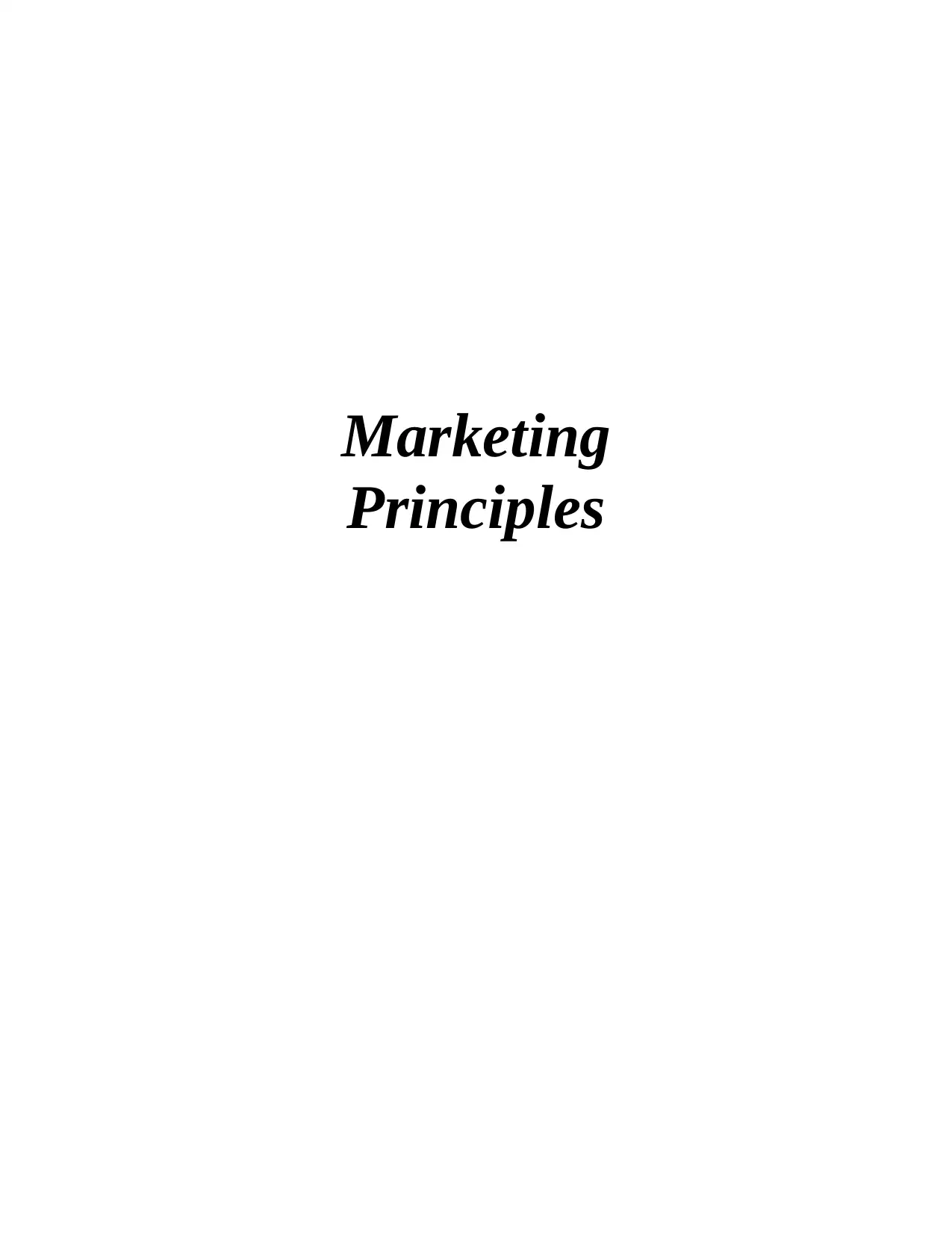
Marketing
Principles
Principles
Paraphrase This Document
Need a fresh take? Get an instant paraphrase of this document with our AI Paraphraser
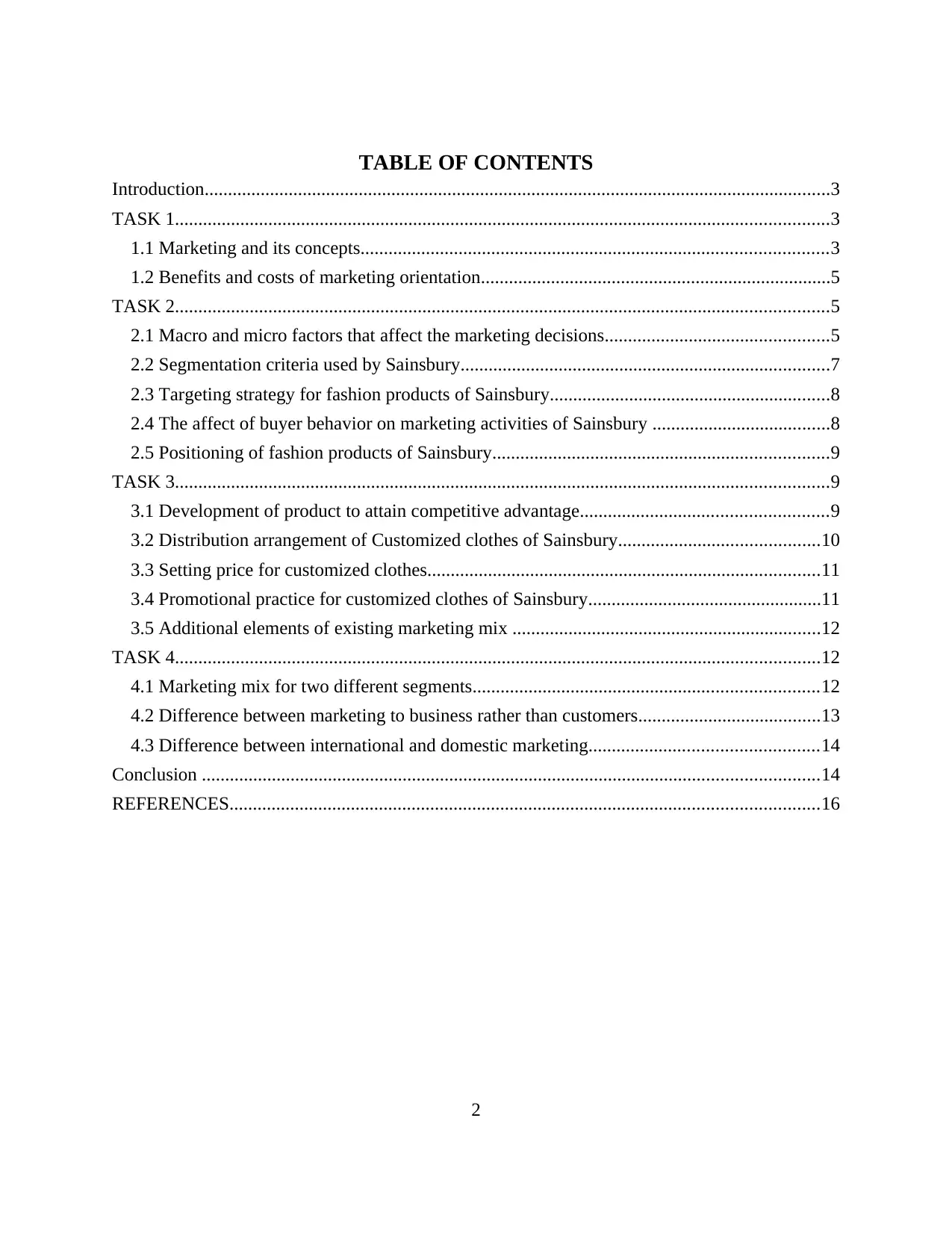
TABLE OF CONTENTS
Introduction......................................................................................................................................3
TASK 1............................................................................................................................................3
1.1 Marketing and its concepts....................................................................................................3
1.2 Benefits and costs of marketing orientation...........................................................................5
TASK 2............................................................................................................................................5
2.1 Macro and micro factors that affect the marketing decisions................................................5
2.2 Segmentation criteria used by Sainsbury...............................................................................7
2.3 Targeting strategy for fashion products of Sainsbury............................................................8
2.4 The affect of buyer behavior on marketing activities of Sainsbury ......................................8
2.5 Positioning of fashion products of Sainsbury........................................................................9
TASK 3............................................................................................................................................9
3.1 Development of product to attain competitive advantage.....................................................9
3.2 Distribution arrangement of Customized clothes of Sainsbury...........................................10
3.3 Setting price for customized clothes....................................................................................11
3.4 Promotional practice for customized clothes of Sainsbury..................................................11
3.5 Additional elements of existing marketing mix ..................................................................12
TASK 4..........................................................................................................................................12
4.1 Marketing mix for two different segments..........................................................................12
4.2 Difference between marketing to business rather than customers.......................................13
4.3 Difference between international and domestic marketing.................................................14
Conclusion ....................................................................................................................................14
REFERENCES..............................................................................................................................16
2
Introduction......................................................................................................................................3
TASK 1............................................................................................................................................3
1.1 Marketing and its concepts....................................................................................................3
1.2 Benefits and costs of marketing orientation...........................................................................5
TASK 2............................................................................................................................................5
2.1 Macro and micro factors that affect the marketing decisions................................................5
2.2 Segmentation criteria used by Sainsbury...............................................................................7
2.3 Targeting strategy for fashion products of Sainsbury............................................................8
2.4 The affect of buyer behavior on marketing activities of Sainsbury ......................................8
2.5 Positioning of fashion products of Sainsbury........................................................................9
TASK 3............................................................................................................................................9
3.1 Development of product to attain competitive advantage.....................................................9
3.2 Distribution arrangement of Customized clothes of Sainsbury...........................................10
3.3 Setting price for customized clothes....................................................................................11
3.4 Promotional practice for customized clothes of Sainsbury..................................................11
3.5 Additional elements of existing marketing mix ..................................................................12
TASK 4..........................................................................................................................................12
4.1 Marketing mix for two different segments..........................................................................12
4.2 Difference between marketing to business rather than customers.......................................13
4.3 Difference between international and domestic marketing.................................................14
Conclusion ....................................................................................................................................14
REFERENCES..............................................................................................................................16
2
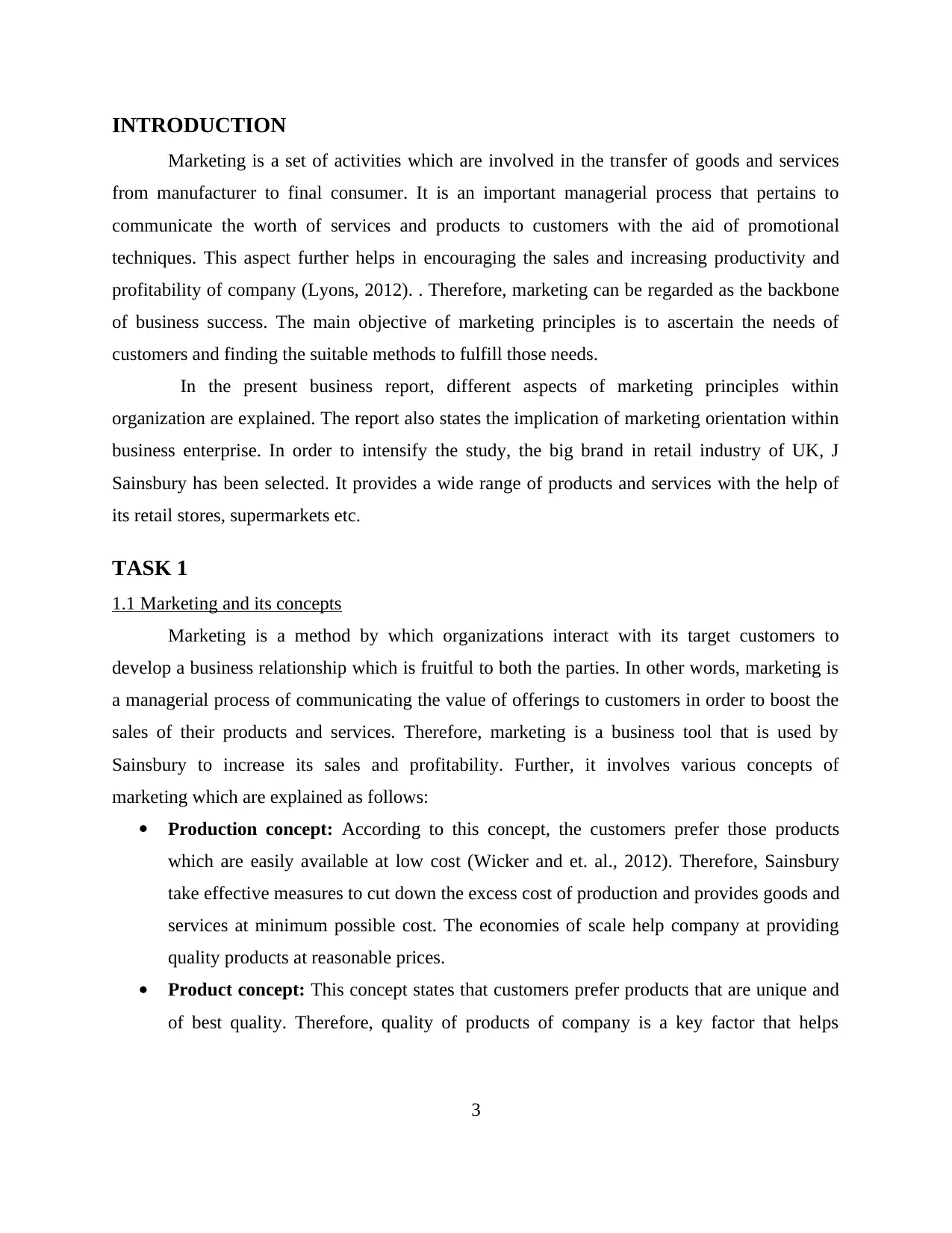
INTRODUCTION
Marketing is a set of activities which are involved in the transfer of goods and services
from manufacturer to final consumer. It is an important managerial process that pertains to
communicate the worth of services and products to customers with the aid of promotional
techniques. This aspect further helps in encouraging the sales and increasing productivity and
profitability of company (Lyons, 2012). . Therefore, marketing can be regarded as the backbone
of business success. The main objective of marketing principles is to ascertain the needs of
customers and finding the suitable methods to fulfill those needs.
In the present business report, different aspects of marketing principles within
organization are explained. The report also states the implication of marketing orientation within
business enterprise. In order to intensify the study, the big brand in retail industry of UK, J
Sainsbury has been selected. It provides a wide range of products and services with the help of
its retail stores, supermarkets etc.
TASK 1
1.1 Marketing and its concepts
Marketing is a method by which organizations interact with its target customers to
develop a business relationship which is fruitful to both the parties. In other words, marketing is
a managerial process of communicating the value of offerings to customers in order to boost the
sales of their products and services. Therefore, marketing is a business tool that is used by
Sainsbury to increase its sales and profitability. Further, it involves various concepts of
marketing which are explained as follows:
Production concept: According to this concept, the customers prefer those products
which are easily available at low cost (Wicker and et. al., 2012). Therefore, Sainsbury
take effective measures to cut down the excess cost of production and provides goods and
services at minimum possible cost. The economies of scale help company at providing
quality products at reasonable prices.
Product concept: This concept states that customers prefer products that are unique and
of best quality. Therefore, quality of products of company is a key factor that helps
3
Marketing is a set of activities which are involved in the transfer of goods and services
from manufacturer to final consumer. It is an important managerial process that pertains to
communicate the worth of services and products to customers with the aid of promotional
techniques. This aspect further helps in encouraging the sales and increasing productivity and
profitability of company (Lyons, 2012). . Therefore, marketing can be regarded as the backbone
of business success. The main objective of marketing principles is to ascertain the needs of
customers and finding the suitable methods to fulfill those needs.
In the present business report, different aspects of marketing principles within
organization are explained. The report also states the implication of marketing orientation within
business enterprise. In order to intensify the study, the big brand in retail industry of UK, J
Sainsbury has been selected. It provides a wide range of products and services with the help of
its retail stores, supermarkets etc.
TASK 1
1.1 Marketing and its concepts
Marketing is a method by which organizations interact with its target customers to
develop a business relationship which is fruitful to both the parties. In other words, marketing is
a managerial process of communicating the value of offerings to customers in order to boost the
sales of their products and services. Therefore, marketing is a business tool that is used by
Sainsbury to increase its sales and profitability. Further, it involves various concepts of
marketing which are explained as follows:
Production concept: According to this concept, the customers prefer those products
which are easily available at low cost (Wicker and et. al., 2012). Therefore, Sainsbury
take effective measures to cut down the excess cost of production and provides goods and
services at minimum possible cost. The economies of scale help company at providing
quality products at reasonable prices.
Product concept: This concept states that customers prefer products that are unique and
of best quality. Therefore, quality of products of company is a key factor that helps
3
⊘ This is a preview!⊘
Do you want full access?
Subscribe today to unlock all pages.

Trusted by 1+ million students worldwide
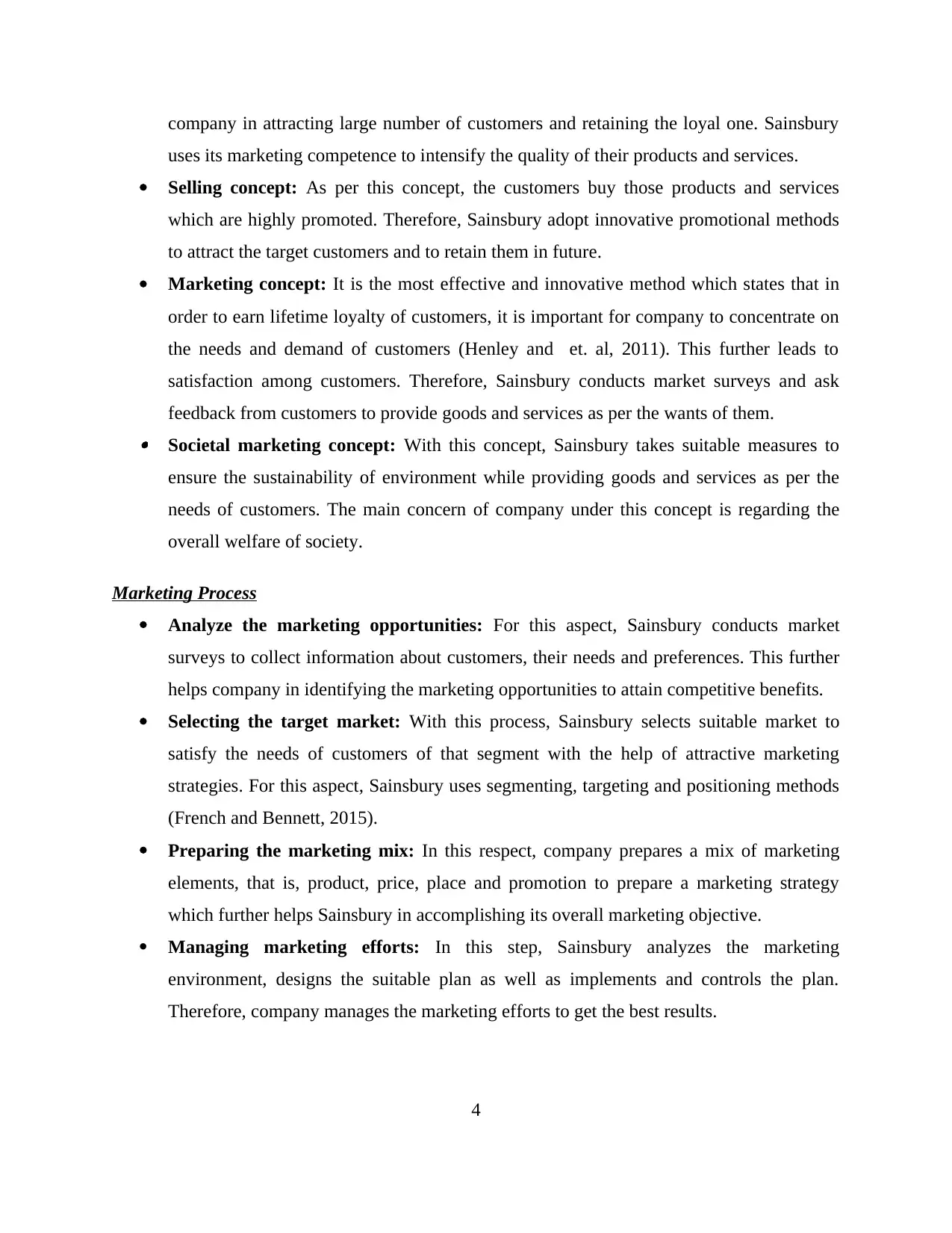
company in attracting large number of customers and retaining the loyal one. Sainsbury
uses its marketing competence to intensify the quality of their products and services.
Selling concept: As per this concept, the customers buy those products and services
which are highly promoted. Therefore, Sainsbury adopt innovative promotional methods
to attract the target customers and to retain them in future.
Marketing concept: It is the most effective and innovative method which states that in
order to earn lifetime loyalty of customers, it is important for company to concentrate on
the needs and demand of customers (Henley and et. al, 2011). This further leads to
satisfaction among customers. Therefore, Sainsbury conducts market surveys and ask
feedback from customers to provide goods and services as per the wants of them. Societal marketing concept: With this concept, Sainsbury takes suitable measures to
ensure the sustainability of environment while providing goods and services as per the
needs of customers. The main concern of company under this concept is regarding the
overall welfare of society.
Marketing Process
Analyze the marketing opportunities: For this aspect, Sainsbury conducts market
surveys to collect information about customers, their needs and preferences. This further
helps company in identifying the marketing opportunities to attain competitive benefits.
Selecting the target market: With this process, Sainsbury selects suitable market to
satisfy the needs of customers of that segment with the help of attractive marketing
strategies. For this aspect, Sainsbury uses segmenting, targeting and positioning methods
(French and Bennett, 2015).
Preparing the marketing mix: In this respect, company prepares a mix of marketing
elements, that is, product, price, place and promotion to prepare a marketing strategy
which further helps Sainsbury in accomplishing its overall marketing objective.
Managing marketing efforts: In this step, Sainsbury analyzes the marketing
environment, designs the suitable plan as well as implements and controls the plan.
Therefore, company manages the marketing efforts to get the best results.
4
uses its marketing competence to intensify the quality of their products and services.
Selling concept: As per this concept, the customers buy those products and services
which are highly promoted. Therefore, Sainsbury adopt innovative promotional methods
to attract the target customers and to retain them in future.
Marketing concept: It is the most effective and innovative method which states that in
order to earn lifetime loyalty of customers, it is important for company to concentrate on
the needs and demand of customers (Henley and et. al, 2011). This further leads to
satisfaction among customers. Therefore, Sainsbury conducts market surveys and ask
feedback from customers to provide goods and services as per the wants of them. Societal marketing concept: With this concept, Sainsbury takes suitable measures to
ensure the sustainability of environment while providing goods and services as per the
needs of customers. The main concern of company under this concept is regarding the
overall welfare of society.
Marketing Process
Analyze the marketing opportunities: For this aspect, Sainsbury conducts market
surveys to collect information about customers, their needs and preferences. This further
helps company in identifying the marketing opportunities to attain competitive benefits.
Selecting the target market: With this process, Sainsbury selects suitable market to
satisfy the needs of customers of that segment with the help of attractive marketing
strategies. For this aspect, Sainsbury uses segmenting, targeting and positioning methods
(French and Bennett, 2015).
Preparing the marketing mix: In this respect, company prepares a mix of marketing
elements, that is, product, price, place and promotion to prepare a marketing strategy
which further helps Sainsbury in accomplishing its overall marketing objective.
Managing marketing efforts: In this step, Sainsbury analyzes the marketing
environment, designs the suitable plan as well as implements and controls the plan.
Therefore, company manages the marketing efforts to get the best results.
4
Paraphrase This Document
Need a fresh take? Get an instant paraphrase of this document with our AI Paraphraser
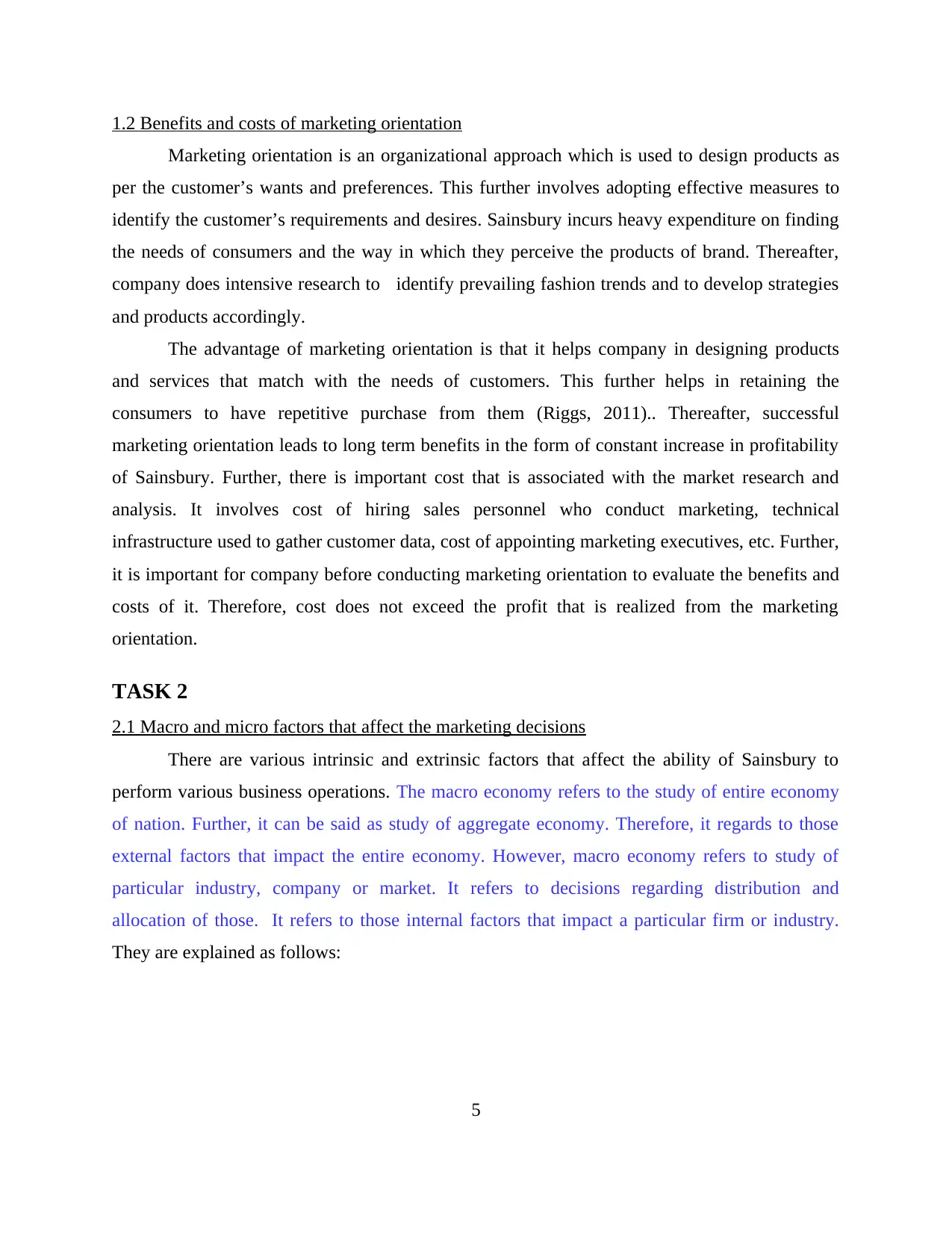
1.2 Benefits and costs of marketing orientation
Marketing orientation is an organizational approach which is used to design products as
per the customer’s wants and preferences. This further involves adopting effective measures to
identify the customer’s requirements and desires. Sainsbury incurs heavy expenditure on finding
the needs of consumers and the way in which they perceive the products of brand. Thereafter,
company does intensive research to identify prevailing fashion trends and to develop strategies
and products accordingly.
The advantage of marketing orientation is that it helps company in designing products
and services that match with the needs of customers. This further helps in retaining the
consumers to have repetitive purchase from them (Riggs, 2011).. Thereafter, successful
marketing orientation leads to long term benefits in the form of constant increase in profitability
of Sainsbury. Further, there is important cost that is associated with the market research and
analysis. It involves cost of hiring sales personnel who conduct marketing, technical
infrastructure used to gather customer data, cost of appointing marketing executives, etc. Further,
it is important for company before conducting marketing orientation to evaluate the benefits and
costs of it. Therefore, cost does not exceed the profit that is realized from the marketing
orientation.
TASK 2
2.1 Macro and micro factors that affect the marketing decisions
There are various intrinsic and extrinsic factors that affect the ability of Sainsbury to
perform various business operations. The macro economy refers to the study of entire economy
of nation. Further, it can be said as study of aggregate economy. Therefore, it regards to those
external factors that impact the entire economy. However, macro economy refers to study of
particular industry, company or market. It refers to decisions regarding distribution and
allocation of those. It refers to those internal factors that impact a particular firm or industry.
They are explained as follows:
5
Marketing orientation is an organizational approach which is used to design products as
per the customer’s wants and preferences. This further involves adopting effective measures to
identify the customer’s requirements and desires. Sainsbury incurs heavy expenditure on finding
the needs of consumers and the way in which they perceive the products of brand. Thereafter,
company does intensive research to identify prevailing fashion trends and to develop strategies
and products accordingly.
The advantage of marketing orientation is that it helps company in designing products
and services that match with the needs of customers. This further helps in retaining the
consumers to have repetitive purchase from them (Riggs, 2011).. Thereafter, successful
marketing orientation leads to long term benefits in the form of constant increase in profitability
of Sainsbury. Further, there is important cost that is associated with the market research and
analysis. It involves cost of hiring sales personnel who conduct marketing, technical
infrastructure used to gather customer data, cost of appointing marketing executives, etc. Further,
it is important for company before conducting marketing orientation to evaluate the benefits and
costs of it. Therefore, cost does not exceed the profit that is realized from the marketing
orientation.
TASK 2
2.1 Macro and micro factors that affect the marketing decisions
There are various intrinsic and extrinsic factors that affect the ability of Sainsbury to
perform various business operations. The macro economy refers to the study of entire economy
of nation. Further, it can be said as study of aggregate economy. Therefore, it regards to those
external factors that impact the entire economy. However, macro economy refers to study of
particular industry, company or market. It refers to decisions regarding distribution and
allocation of those. It refers to those internal factors that impact a particular firm or industry.
They are explained as follows:
5
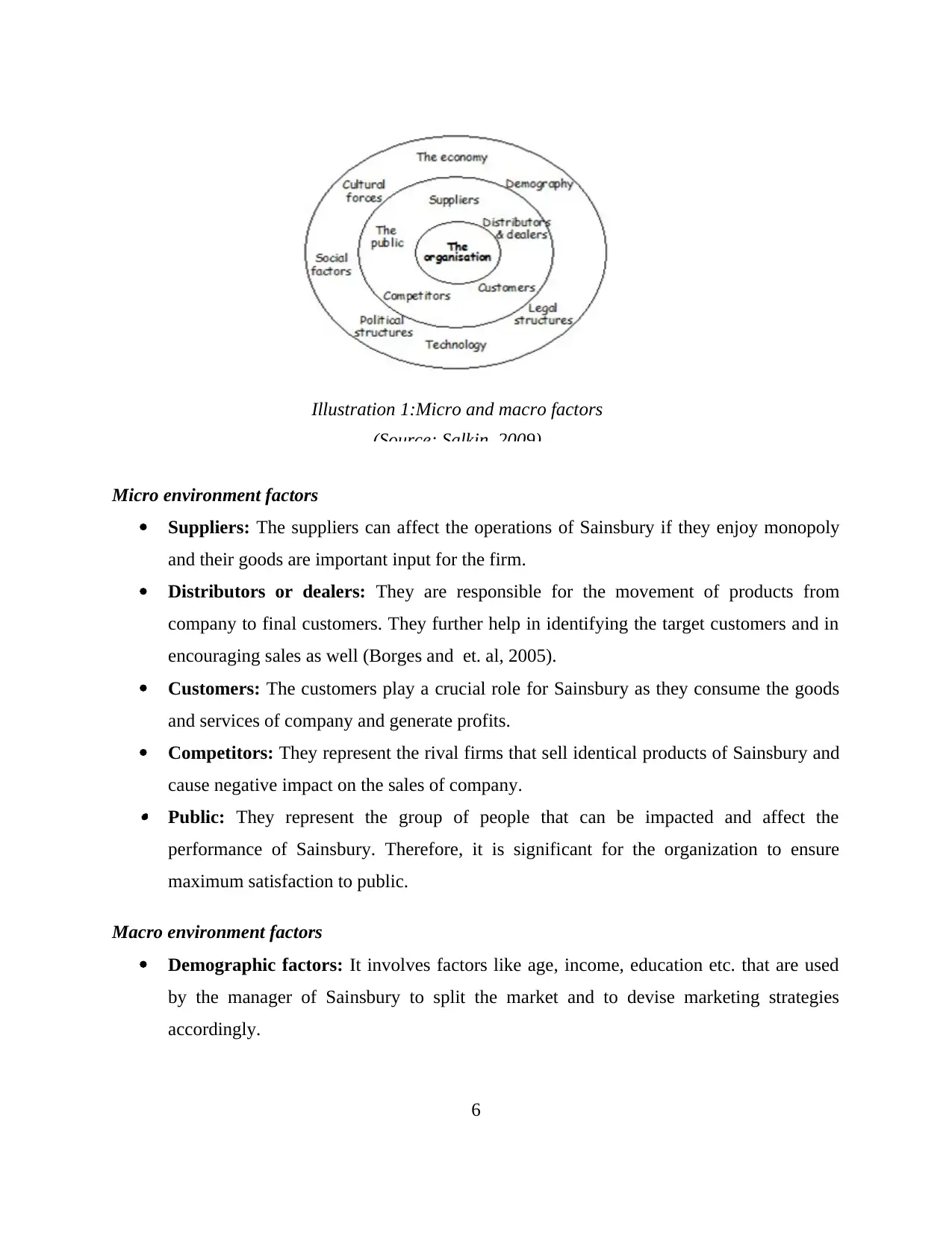
Micro environment factors
Suppliers: The suppliers can affect the operations of Sainsbury if they enjoy monopoly
and their goods are important input for the firm.
Distributors or dealers: They are responsible for the movement of products from
company to final customers. They further help in identifying the target customers and in
encouraging sales as well (Borges and et. al, 2005).
Customers: The customers play a crucial role for Sainsbury as they consume the goods
and services of company and generate profits.
Competitors: They represent the rival firms that sell identical products of Sainsbury and
cause negative impact on the sales of company. Public: They represent the group of people that can be impacted and affect the
performance of Sainsbury. Therefore, it is significant for the organization to ensure
maximum satisfaction to public.
Macro environment factors
Demographic factors: It involves factors like age, income, education etc. that are used
by the manager of Sainsbury to split the market and to devise marketing strategies
accordingly.
6
Illustration 1:Micro and macro factors
(Source: Salkin, 2009)
Suppliers: The suppliers can affect the operations of Sainsbury if they enjoy monopoly
and their goods are important input for the firm.
Distributors or dealers: They are responsible for the movement of products from
company to final customers. They further help in identifying the target customers and in
encouraging sales as well (Borges and et. al, 2005).
Customers: The customers play a crucial role for Sainsbury as they consume the goods
and services of company and generate profits.
Competitors: They represent the rival firms that sell identical products of Sainsbury and
cause negative impact on the sales of company. Public: They represent the group of people that can be impacted and affect the
performance of Sainsbury. Therefore, it is significant for the organization to ensure
maximum satisfaction to public.
Macro environment factors
Demographic factors: It involves factors like age, income, education etc. that are used
by the manager of Sainsbury to split the market and to devise marketing strategies
accordingly.
6
Illustration 1:Micro and macro factors
(Source: Salkin, 2009)
⊘ This is a preview!⊘
Do you want full access?
Subscribe today to unlock all pages.

Trusted by 1+ million students worldwide
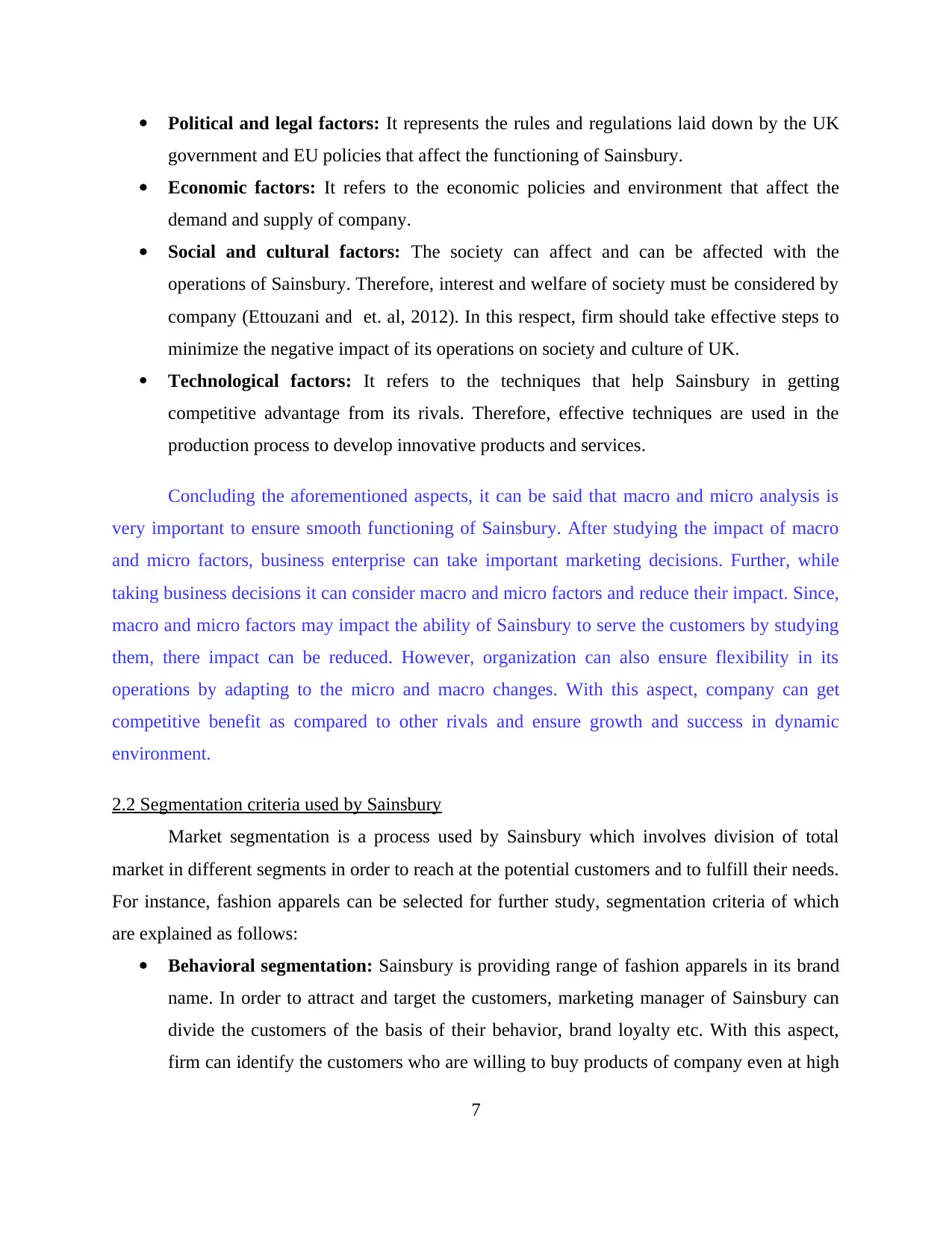
Political and legal factors: It represents the rules and regulations laid down by the UK
government and EU policies that affect the functioning of Sainsbury.
Economic factors: It refers to the economic policies and environment that affect the
demand and supply of company.
Social and cultural factors: The society can affect and can be affected with the
operations of Sainsbury. Therefore, interest and welfare of society must be considered by
company (Ettouzani and et. al, 2012). In this respect, firm should take effective steps to
minimize the negative impact of its operations on society and culture of UK.
Technological factors: It refers to the techniques that help Sainsbury in getting
competitive advantage from its rivals. Therefore, effective techniques are used in the
production process to develop innovative products and services.
Concluding the aforementioned aspects, it can be said that macro and micro analysis is
very important to ensure smooth functioning of Sainsbury. After studying the impact of macro
and micro factors, business enterprise can take important marketing decisions. Further, while
taking business decisions it can consider macro and micro factors and reduce their impact. Since,
macro and micro factors may impact the ability of Sainsbury to serve the customers by studying
them, there impact can be reduced. However, organization can also ensure flexibility in its
operations by adapting to the micro and macro changes. With this aspect, company can get
competitive benefit as compared to other rivals and ensure growth and success in dynamic
environment.
2.2 Segmentation criteria used by Sainsbury
Market segmentation is a process used by Sainsbury which involves division of total
market in different segments in order to reach at the potential customers and to fulfill their needs.
For instance, fashion apparels can be selected for further study, segmentation criteria of which
are explained as follows:
Behavioral segmentation: Sainsbury is providing range of fashion apparels in its brand
name. In order to attract and target the customers, marketing manager of Sainsbury can
divide the customers of the basis of their behavior, brand loyalty etc. With this aspect,
firm can identify the customers who are willing to buy products of company even at high
7
government and EU policies that affect the functioning of Sainsbury.
Economic factors: It refers to the economic policies and environment that affect the
demand and supply of company.
Social and cultural factors: The society can affect and can be affected with the
operations of Sainsbury. Therefore, interest and welfare of society must be considered by
company (Ettouzani and et. al, 2012). In this respect, firm should take effective steps to
minimize the negative impact of its operations on society and culture of UK.
Technological factors: It refers to the techniques that help Sainsbury in getting
competitive advantage from its rivals. Therefore, effective techniques are used in the
production process to develop innovative products and services.
Concluding the aforementioned aspects, it can be said that macro and micro analysis is
very important to ensure smooth functioning of Sainsbury. After studying the impact of macro
and micro factors, business enterprise can take important marketing decisions. Further, while
taking business decisions it can consider macro and micro factors and reduce their impact. Since,
macro and micro factors may impact the ability of Sainsbury to serve the customers by studying
them, there impact can be reduced. However, organization can also ensure flexibility in its
operations by adapting to the micro and macro changes. With this aspect, company can get
competitive benefit as compared to other rivals and ensure growth and success in dynamic
environment.
2.2 Segmentation criteria used by Sainsbury
Market segmentation is a process used by Sainsbury which involves division of total
market in different segments in order to reach at the potential customers and to fulfill their needs.
For instance, fashion apparels can be selected for further study, segmentation criteria of which
are explained as follows:
Behavioral segmentation: Sainsbury is providing range of fashion apparels in its brand
name. In order to attract and target the customers, marketing manager of Sainsbury can
divide the customers of the basis of their behavior, brand loyalty etc. With this aspect,
firm can identify the customers who are willing to buy products of company even at high
7
Paraphrase This Document
Need a fresh take? Get an instant paraphrase of this document with our AI Paraphraser
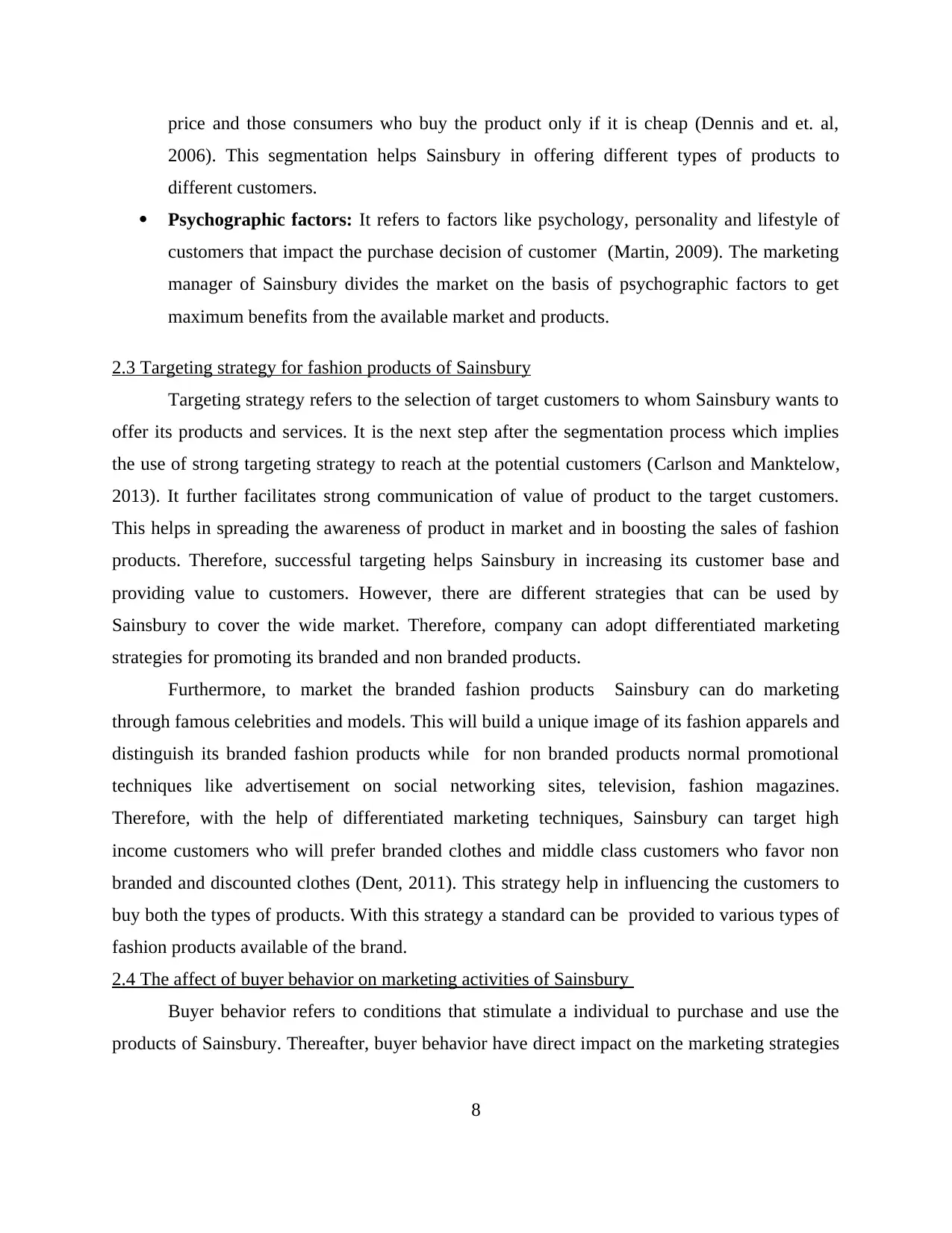
price and those consumers who buy the product only if it is cheap (Dennis and et. al,
2006). This segmentation helps Sainsbury in offering different types of products to
different customers.
Psychographic factors: It refers to factors like psychology, personality and lifestyle of
customers that impact the purchase decision of customer (Martin, 2009). The marketing
manager of Sainsbury divides the market on the basis of psychographic factors to get
maximum benefits from the available market and products.
2.3 Targeting strategy for fashion products of Sainsbury
Targeting strategy refers to the selection of target customers to whom Sainsbury wants to
offer its products and services. It is the next step after the segmentation process which implies
the use of strong targeting strategy to reach at the potential customers (Carlson and Manktelow,
2013). It further facilitates strong communication of value of product to the target customers.
This helps in spreading the awareness of product in market and in boosting the sales of fashion
products. Therefore, successful targeting helps Sainsbury in increasing its customer base and
providing value to customers. However, there are different strategies that can be used by
Sainsbury to cover the wide market. Therefore, company can adopt differentiated marketing
strategies for promoting its branded and non branded products.
Furthermore, to market the branded fashion products Sainsbury can do marketing
through famous celebrities and models. This will build a unique image of its fashion apparels and
distinguish its branded fashion products while for non branded products normal promotional
techniques like advertisement on social networking sites, television, fashion magazines.
Therefore, with the help of differentiated marketing techniques, Sainsbury can target high
income customers who will prefer branded clothes and middle class customers who favor non
branded and discounted clothes (Dent, 2011). This strategy help in influencing the customers to
buy both the types of products. With this strategy a standard can be provided to various types of
fashion products available of the brand.
2.4 The affect of buyer behavior on marketing activities of Sainsbury
Buyer behavior refers to conditions that stimulate a individual to purchase and use the
products of Sainsbury. Thereafter, buyer behavior have direct impact on the marketing strategies
8
2006). This segmentation helps Sainsbury in offering different types of products to
different customers.
Psychographic factors: It refers to factors like psychology, personality and lifestyle of
customers that impact the purchase decision of customer (Martin, 2009). The marketing
manager of Sainsbury divides the market on the basis of psychographic factors to get
maximum benefits from the available market and products.
2.3 Targeting strategy for fashion products of Sainsbury
Targeting strategy refers to the selection of target customers to whom Sainsbury wants to
offer its products and services. It is the next step after the segmentation process which implies
the use of strong targeting strategy to reach at the potential customers (Carlson and Manktelow,
2013). It further facilitates strong communication of value of product to the target customers.
This helps in spreading the awareness of product in market and in boosting the sales of fashion
products. Therefore, successful targeting helps Sainsbury in increasing its customer base and
providing value to customers. However, there are different strategies that can be used by
Sainsbury to cover the wide market. Therefore, company can adopt differentiated marketing
strategies for promoting its branded and non branded products.
Furthermore, to market the branded fashion products Sainsbury can do marketing
through famous celebrities and models. This will build a unique image of its fashion apparels and
distinguish its branded fashion products while for non branded products normal promotional
techniques like advertisement on social networking sites, television, fashion magazines.
Therefore, with the help of differentiated marketing techniques, Sainsbury can target high
income customers who will prefer branded clothes and middle class customers who favor non
branded and discounted clothes (Dent, 2011). This strategy help in influencing the customers to
buy both the types of products. With this strategy a standard can be provided to various types of
fashion products available of the brand.
2.4 The affect of buyer behavior on marketing activities of Sainsbury
Buyer behavior refers to conditions that stimulate a individual to purchase and use the
products of Sainsbury. Thereafter, buyer behavior have direct impact on the marketing strategies
8
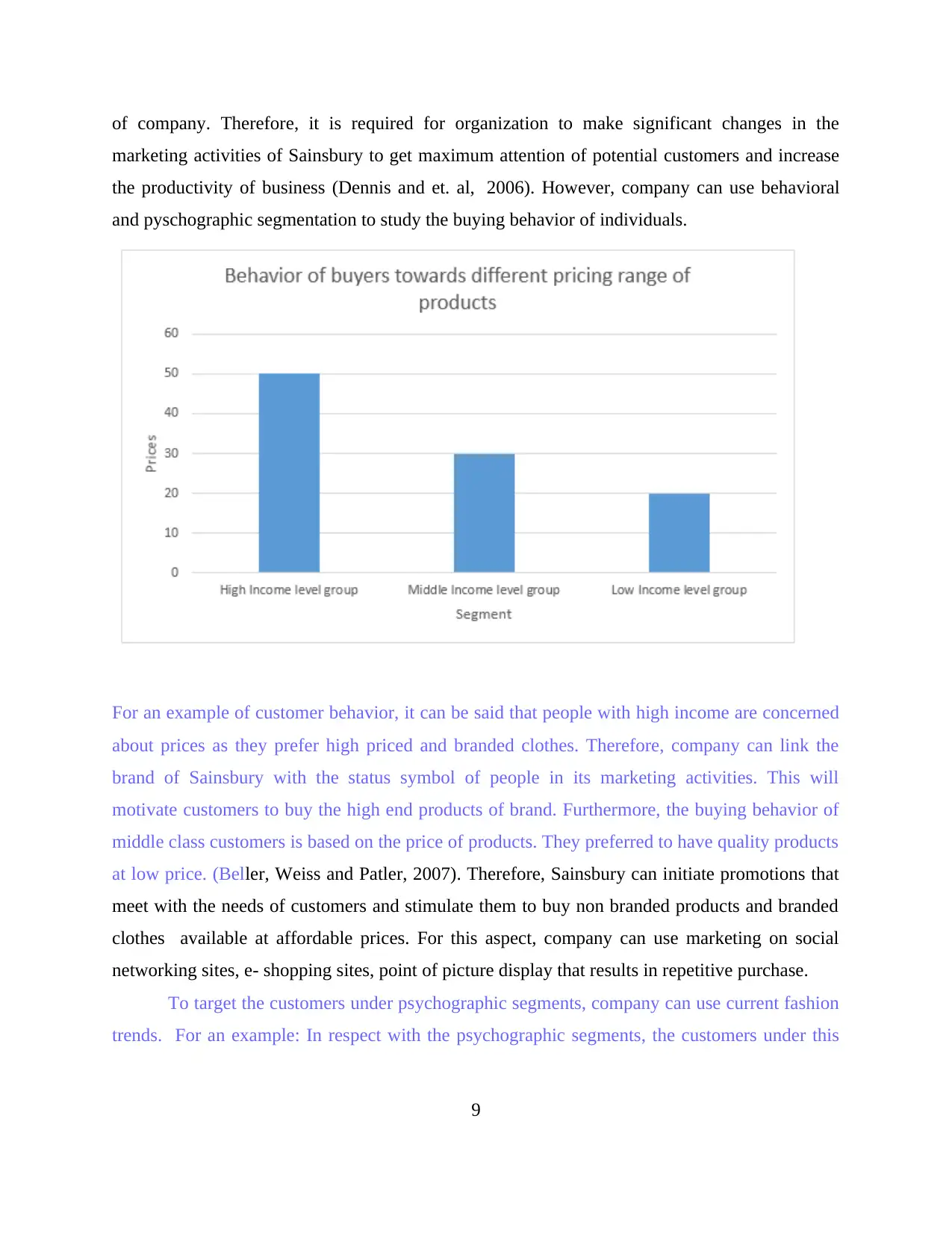
of company. Therefore, it is required for organization to make significant changes in the
marketing activities of Sainsbury to get maximum attention of potential customers and increase
the productivity of business (Dennis and et. al, 2006). However, company can use behavioral
and pyschographic segmentation to study the buying behavior of individuals.
For an example of customer behavior, it can be said that people with high income are concerned
about prices as they prefer high priced and branded clothes. Therefore, company can link the
brand of Sainsbury with the status symbol of people in its marketing activities. This will
motivate customers to buy the high end products of brand. Furthermore, the buying behavior of
middle class customers is based on the price of products. They preferred to have quality products
at low price. (Beller, Weiss and Patler, 2007). Therefore, Sainsbury can initiate promotions that
meet with the needs of customers and stimulate them to buy non branded products and branded
clothes available at affordable prices. For this aspect, company can use marketing on social
networking sites, e- shopping sites, point of picture display that results in repetitive purchase.
To target the customers under psychographic segments, company can use current fashion
trends. For an example: In respect with the psychographic segments, the customers under this
9
marketing activities of Sainsbury to get maximum attention of potential customers and increase
the productivity of business (Dennis and et. al, 2006). However, company can use behavioral
and pyschographic segmentation to study the buying behavior of individuals.
For an example of customer behavior, it can be said that people with high income are concerned
about prices as they prefer high priced and branded clothes. Therefore, company can link the
brand of Sainsbury with the status symbol of people in its marketing activities. This will
motivate customers to buy the high end products of brand. Furthermore, the buying behavior of
middle class customers is based on the price of products. They preferred to have quality products
at low price. (Beller, Weiss and Patler, 2007). Therefore, Sainsbury can initiate promotions that
meet with the needs of customers and stimulate them to buy non branded products and branded
clothes available at affordable prices. For this aspect, company can use marketing on social
networking sites, e- shopping sites, point of picture display that results in repetitive purchase.
To target the customers under psychographic segments, company can use current fashion
trends. For an example: In respect with the psychographic segments, the customers under this
9
⊘ This is a preview!⊘
Do you want full access?
Subscribe today to unlock all pages.

Trusted by 1+ million students worldwide
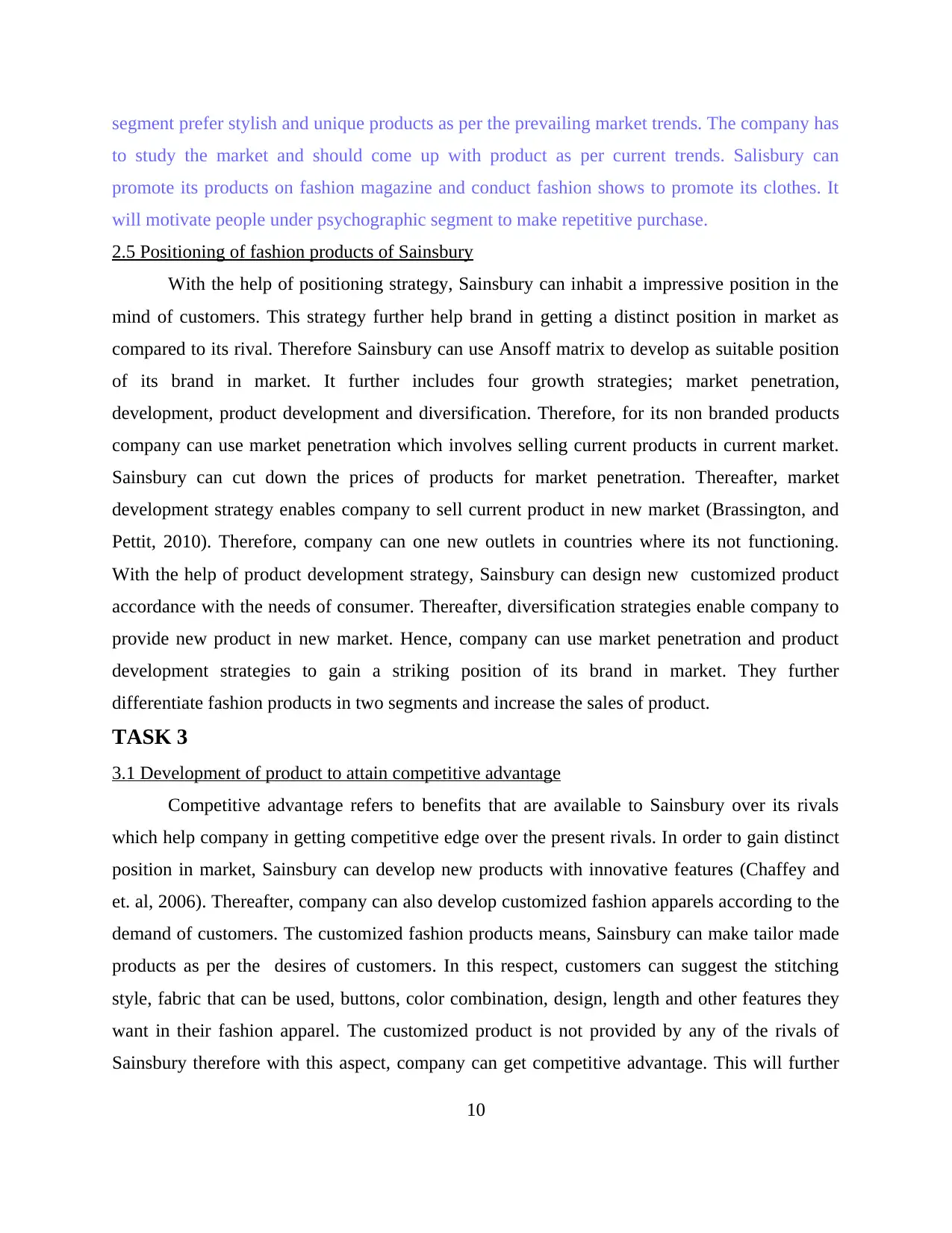
segment prefer stylish and unique products as per the prevailing market trends. The company has
to study the market and should come up with product as per current trends. Salisbury can
promote its products on fashion magazine and conduct fashion shows to promote its clothes. It
will motivate people under psychographic segment to make repetitive purchase.
2.5 Positioning of fashion products of Sainsbury
With the help of positioning strategy, Sainsbury can inhabit a impressive position in the
mind of customers. This strategy further help brand in getting a distinct position in market as
compared to its rival. Therefore Sainsbury can use Ansoff matrix to develop as suitable position
of its brand in market. It further includes four growth strategies; market penetration,
development, product development and diversification. Therefore, for its non branded products
company can use market penetration which involves selling current products in current market.
Sainsbury can cut down the prices of products for market penetration. Thereafter, market
development strategy enables company to sell current product in new market (Brassington, and
Pettit, 2010). Therefore, company can one new outlets in countries where its not functioning.
With the help of product development strategy, Sainsbury can design new customized product
accordance with the needs of consumer. Thereafter, diversification strategies enable company to
provide new product in new market. Hence, company can use market penetration and product
development strategies to gain a striking position of its brand in market. They further
differentiate fashion products in two segments and increase the sales of product.
TASK 3
3.1 Development of product to attain competitive advantage
Competitive advantage refers to benefits that are available to Sainsbury over its rivals
which help company in getting competitive edge over the present rivals. In order to gain distinct
position in market, Sainsbury can develop new products with innovative features (Chaffey and
et. al, 2006). Thereafter, company can also develop customized fashion apparels according to the
demand of customers. The customized fashion products means, Sainsbury can make tailor made
products as per the desires of customers. In this respect, customers can suggest the stitching
style, fabric that can be used, buttons, color combination, design, length and other features they
want in their fashion apparel. The customized product is not provided by any of the rivals of
Sainsbury therefore with this aspect, company can get competitive advantage. This will further
10
to study the market and should come up with product as per current trends. Salisbury can
promote its products on fashion magazine and conduct fashion shows to promote its clothes. It
will motivate people under psychographic segment to make repetitive purchase.
2.5 Positioning of fashion products of Sainsbury
With the help of positioning strategy, Sainsbury can inhabit a impressive position in the
mind of customers. This strategy further help brand in getting a distinct position in market as
compared to its rival. Therefore Sainsbury can use Ansoff matrix to develop as suitable position
of its brand in market. It further includes four growth strategies; market penetration,
development, product development and diversification. Therefore, for its non branded products
company can use market penetration which involves selling current products in current market.
Sainsbury can cut down the prices of products for market penetration. Thereafter, market
development strategy enables company to sell current product in new market (Brassington, and
Pettit, 2010). Therefore, company can one new outlets in countries where its not functioning.
With the help of product development strategy, Sainsbury can design new customized product
accordance with the needs of consumer. Thereafter, diversification strategies enable company to
provide new product in new market. Hence, company can use market penetration and product
development strategies to gain a striking position of its brand in market. They further
differentiate fashion products in two segments and increase the sales of product.
TASK 3
3.1 Development of product to attain competitive advantage
Competitive advantage refers to benefits that are available to Sainsbury over its rivals
which help company in getting competitive edge over the present rivals. In order to gain distinct
position in market, Sainsbury can develop new products with innovative features (Chaffey and
et. al, 2006). Thereafter, company can also develop customized fashion apparels according to the
demand of customers. The customized fashion products means, Sainsbury can make tailor made
products as per the desires of customers. In this respect, customers can suggest the stitching
style, fabric that can be used, buttons, color combination, design, length and other features they
want in their fashion apparel. The customized product is not provided by any of the rivals of
Sainsbury therefore with this aspect, company can get competitive advantage. This will further
10
Paraphrase This Document
Need a fresh take? Get an instant paraphrase of this document with our AI Paraphraser
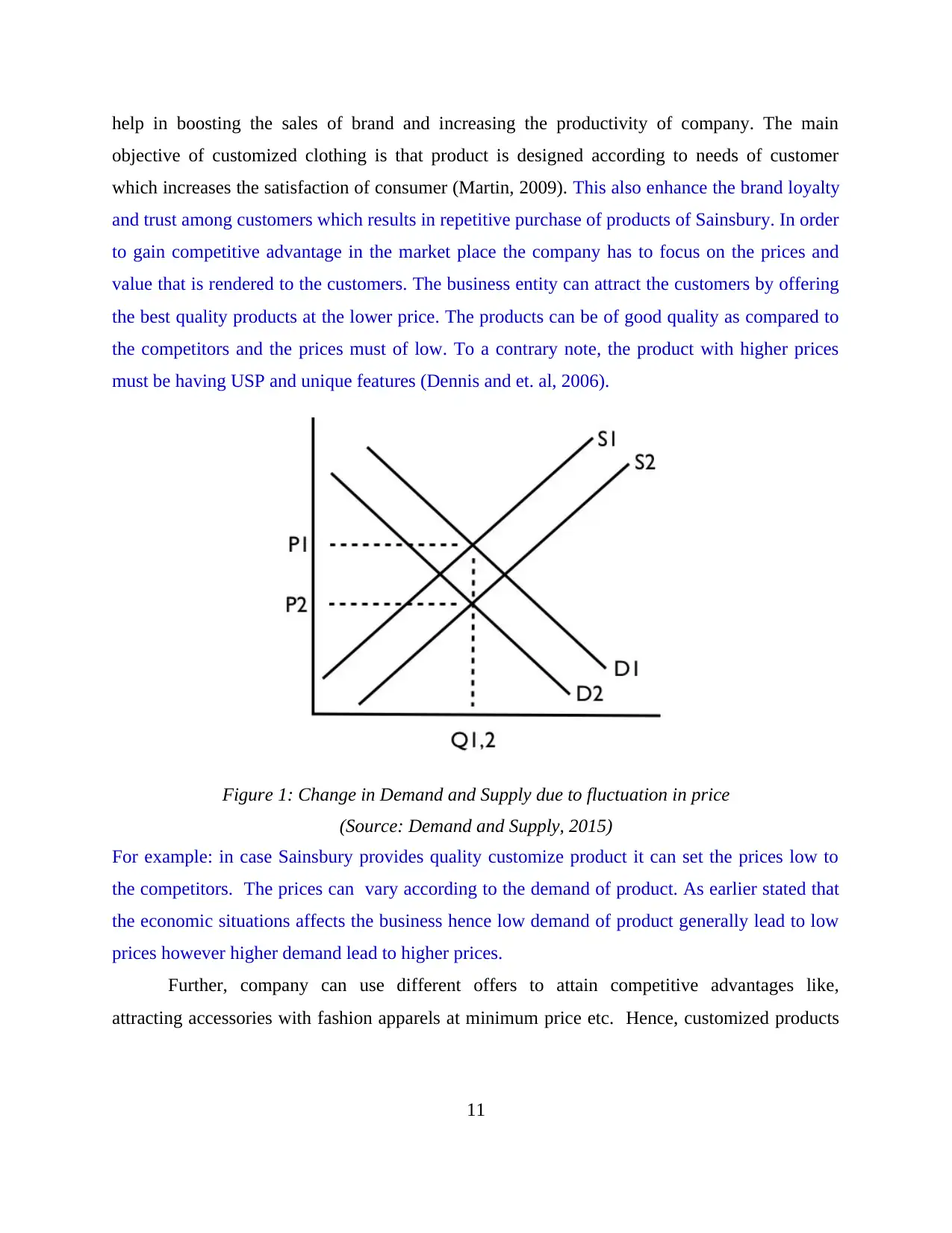
help in boosting the sales of brand and increasing the productivity of company. The main
objective of customized clothing is that product is designed according to needs of customer
which increases the satisfaction of consumer (Martin, 2009). This also enhance the brand loyalty
and trust among customers which results in repetitive purchase of products of Sainsbury. In order
to gain competitive advantage in the market place the company has to focus on the prices and
value that is rendered to the customers. The business entity can attract the customers by offering
the best quality products at the lower price. The products can be of good quality as compared to
the competitors and the prices must of low. To a contrary note, the product with higher prices
must be having USP and unique features (Dennis and et. al, 2006).
Figure 1: Change in Demand and Supply due to fluctuation in price
(Source: Demand and Supply, 2015)
For example: in case Sainsbury provides quality customize product it can set the prices low to
the competitors. The prices can vary according to the demand of product. As earlier stated that
the economic situations affects the business hence low demand of product generally lead to low
prices however higher demand lead to higher prices.
Further, company can use different offers to attain competitive advantages like,
attracting accessories with fashion apparels at minimum price etc. Hence, customized products
11
objective of customized clothing is that product is designed according to needs of customer
which increases the satisfaction of consumer (Martin, 2009). This also enhance the brand loyalty
and trust among customers which results in repetitive purchase of products of Sainsbury. In order
to gain competitive advantage in the market place the company has to focus on the prices and
value that is rendered to the customers. The business entity can attract the customers by offering
the best quality products at the lower price. The products can be of good quality as compared to
the competitors and the prices must of low. To a contrary note, the product with higher prices
must be having USP and unique features (Dennis and et. al, 2006).
Figure 1: Change in Demand and Supply due to fluctuation in price
(Source: Demand and Supply, 2015)
For example: in case Sainsbury provides quality customize product it can set the prices low to
the competitors. The prices can vary according to the demand of product. As earlier stated that
the economic situations affects the business hence low demand of product generally lead to low
prices however higher demand lead to higher prices.
Further, company can use different offers to attain competitive advantages like,
attracting accessories with fashion apparels at minimum price etc. Hence, customized products
11
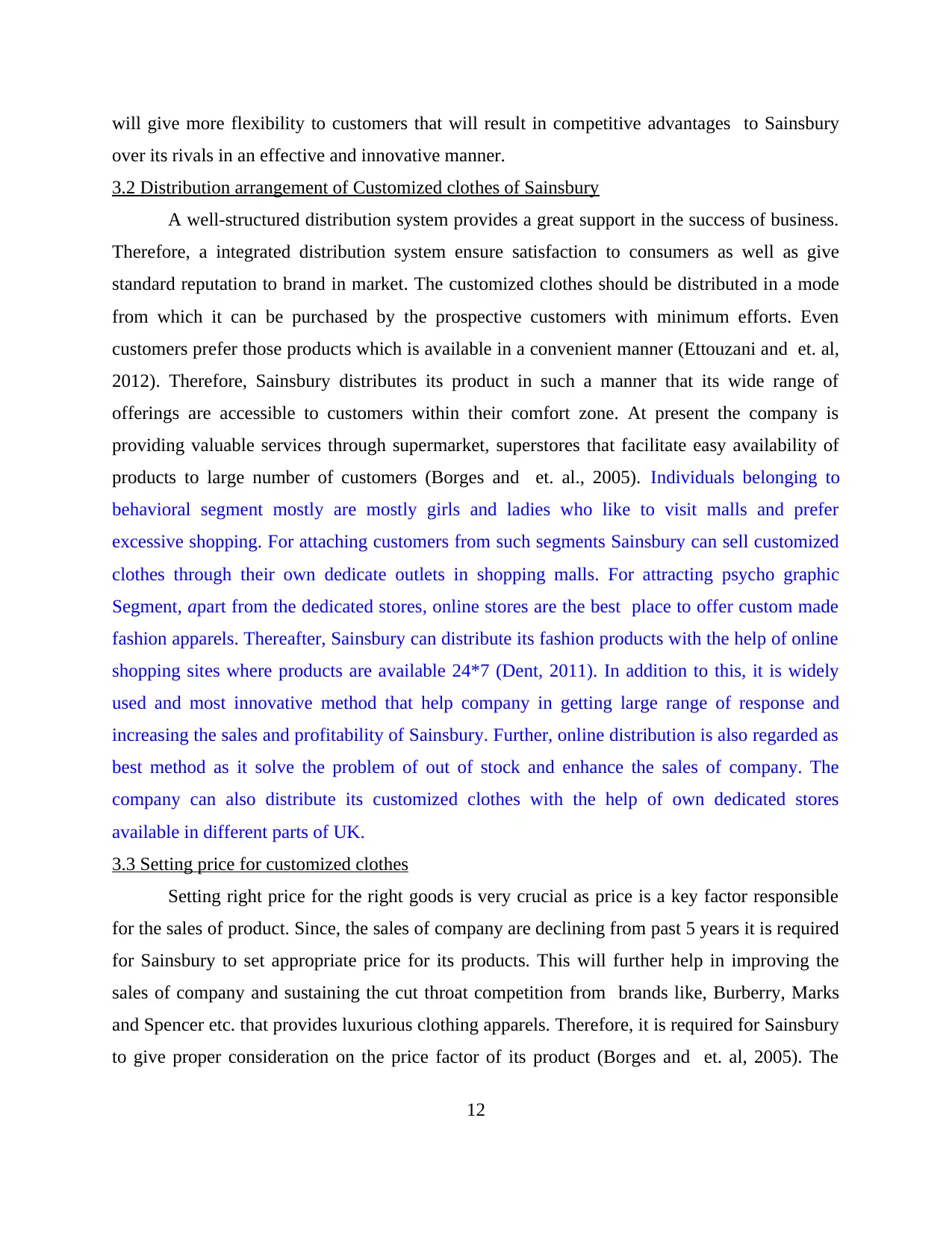
will give more flexibility to customers that will result in competitive advantages to Sainsbury
over its rivals in an effective and innovative manner.
3.2 Distribution arrangement of Customized clothes of Sainsbury
A well-structured distribution system provides a great support in the success of business.
Therefore, a integrated distribution system ensure satisfaction to consumers as well as give
standard reputation to brand in market. The customized clothes should be distributed in a mode
from which it can be purchased by the prospective customers with minimum efforts. Even
customers prefer those products which is available in a convenient manner (Ettouzani and et. al,
2012). Therefore, Sainsbury distributes its product in such a manner that its wide range of
offerings are accessible to customers within their comfort zone. At present the company is
providing valuable services through supermarket, superstores that facilitate easy availability of
products to large number of customers (Borges and et. al., 2005). Individuals belonging to
behavioral segment mostly are mostly girls and ladies who like to visit malls and prefer
excessive shopping. For attaching customers from such segments Sainsbury can sell customized
clothes through their own dedicate outlets in shopping malls. For attracting psycho graphic
Segment, apart from the dedicated stores, online stores are the best place to offer custom made
fashion apparels. Thereafter, Sainsbury can distribute its fashion products with the help of online
shopping sites where products are available 24*7 (Dent, 2011). In addition to this, it is widely
used and most innovative method that help company in getting large range of response and
increasing the sales and profitability of Sainsbury. Further, online distribution is also regarded as
best method as it solve the problem of out of stock and enhance the sales of company. The
company can also distribute its customized clothes with the help of own dedicated stores
available in different parts of UK.
3.3 Setting price for customized clothes
Setting right price for the right goods is very crucial as price is a key factor responsible
for the sales of product. Since, the sales of company are declining from past 5 years it is required
for Sainsbury to set appropriate price for its products. This will further help in improving the
sales of company and sustaining the cut throat competition from brands like, Burberry, Marks
and Spencer etc. that provides luxurious clothing apparels. Therefore, it is required for Sainsbury
to give proper consideration on the price factor of its product (Borges and et. al, 2005). The
12
over its rivals in an effective and innovative manner.
3.2 Distribution arrangement of Customized clothes of Sainsbury
A well-structured distribution system provides a great support in the success of business.
Therefore, a integrated distribution system ensure satisfaction to consumers as well as give
standard reputation to brand in market. The customized clothes should be distributed in a mode
from which it can be purchased by the prospective customers with minimum efforts. Even
customers prefer those products which is available in a convenient manner (Ettouzani and et. al,
2012). Therefore, Sainsbury distributes its product in such a manner that its wide range of
offerings are accessible to customers within their comfort zone. At present the company is
providing valuable services through supermarket, superstores that facilitate easy availability of
products to large number of customers (Borges and et. al., 2005). Individuals belonging to
behavioral segment mostly are mostly girls and ladies who like to visit malls and prefer
excessive shopping. For attaching customers from such segments Sainsbury can sell customized
clothes through their own dedicate outlets in shopping malls. For attracting psycho graphic
Segment, apart from the dedicated stores, online stores are the best place to offer custom made
fashion apparels. Thereafter, Sainsbury can distribute its fashion products with the help of online
shopping sites where products are available 24*7 (Dent, 2011). In addition to this, it is widely
used and most innovative method that help company in getting large range of response and
increasing the sales and profitability of Sainsbury. Further, online distribution is also regarded as
best method as it solve the problem of out of stock and enhance the sales of company. The
company can also distribute its customized clothes with the help of own dedicated stores
available in different parts of UK.
3.3 Setting price for customized clothes
Setting right price for the right goods is very crucial as price is a key factor responsible
for the sales of product. Since, the sales of company are declining from past 5 years it is required
for Sainsbury to set appropriate price for its products. This will further help in improving the
sales of company and sustaining the cut throat competition from brands like, Burberry, Marks
and Spencer etc. that provides luxurious clothing apparels. Therefore, it is required for Sainsbury
to give proper consideration on the price factor of its product (Borges and et. al, 2005). The
12
⊘ This is a preview!⊘
Do you want full access?
Subscribe today to unlock all pages.

Trusted by 1+ million students worldwide
1 out of 18
Related Documents
Your All-in-One AI-Powered Toolkit for Academic Success.
+13062052269
info@desklib.com
Available 24*7 on WhatsApp / Email
![[object Object]](/_next/static/media/star-bottom.7253800d.svg)
Unlock your academic potential
Copyright © 2020–2025 A2Z Services. All Rights Reserved. Developed and managed by ZUCOL.





